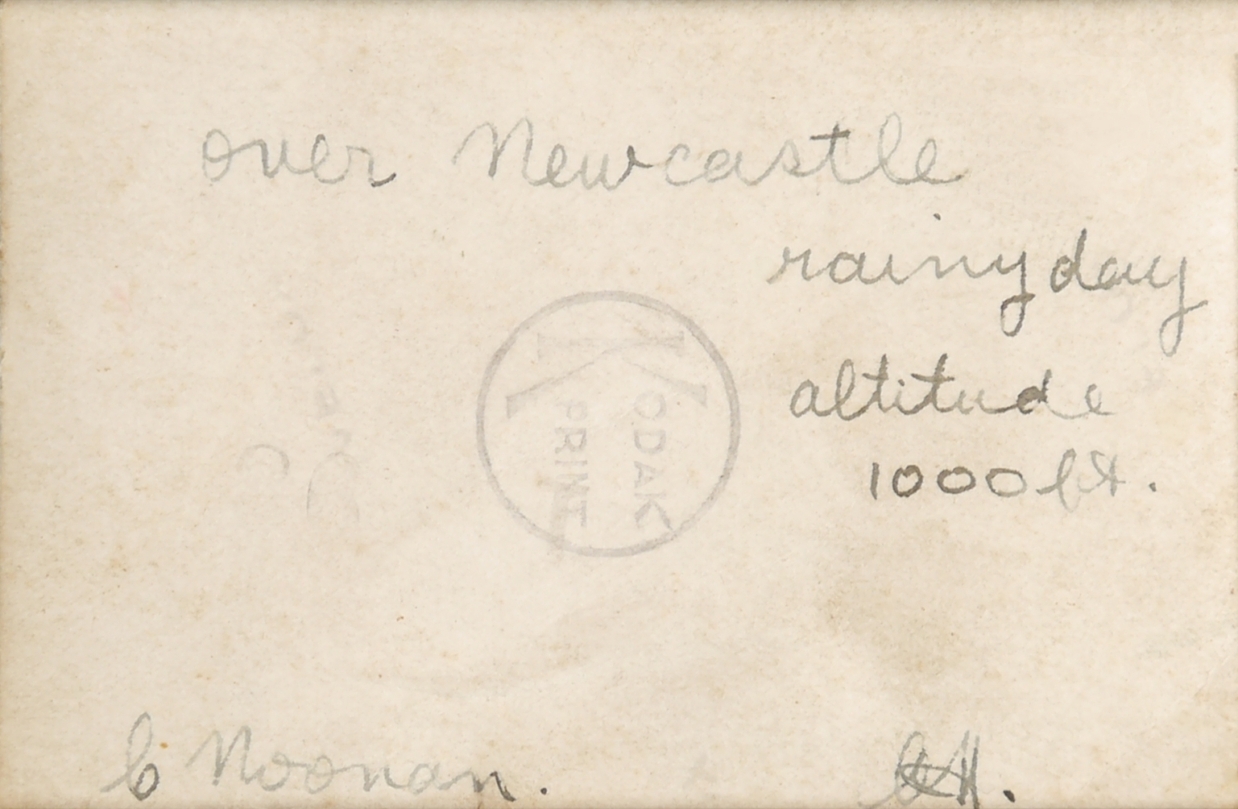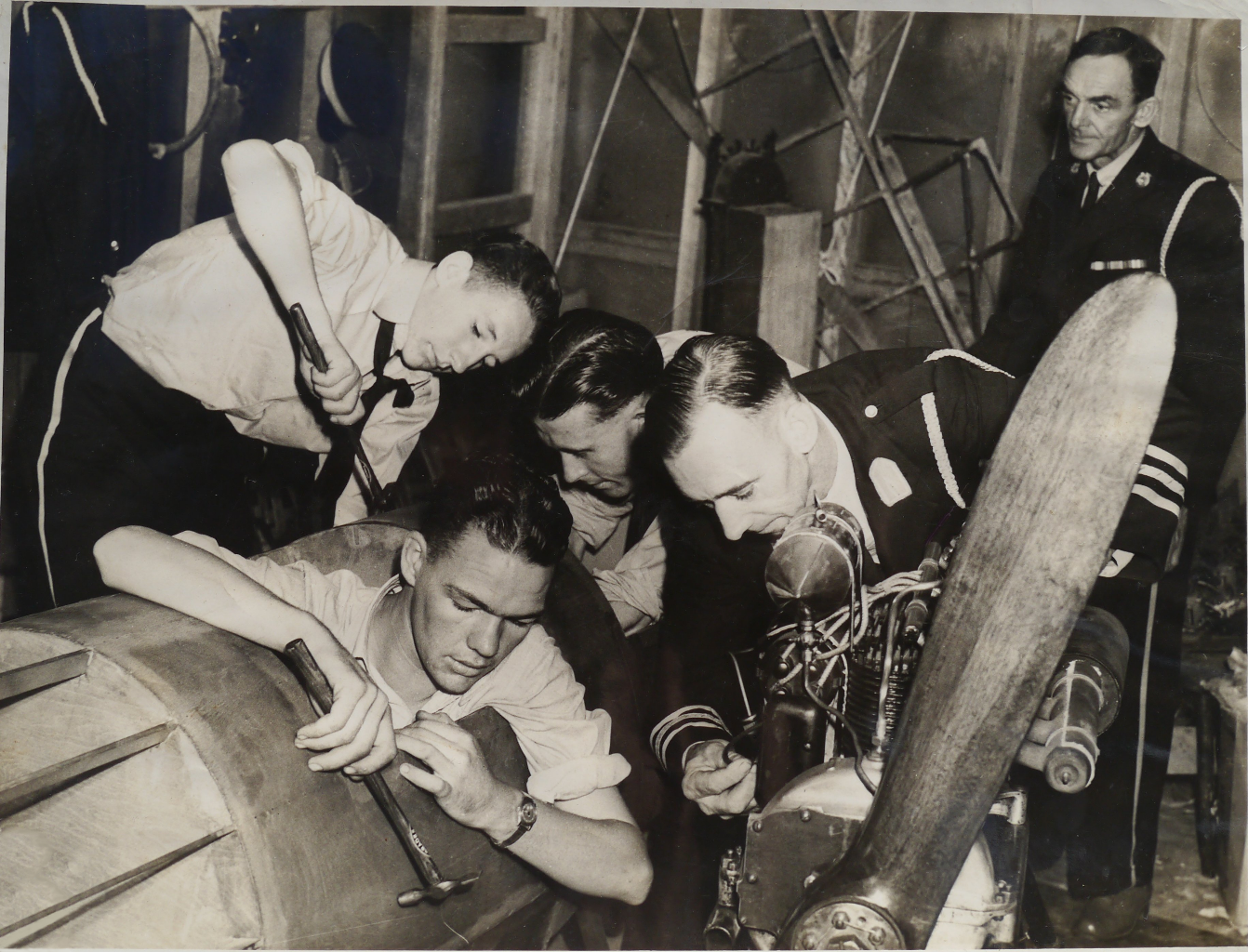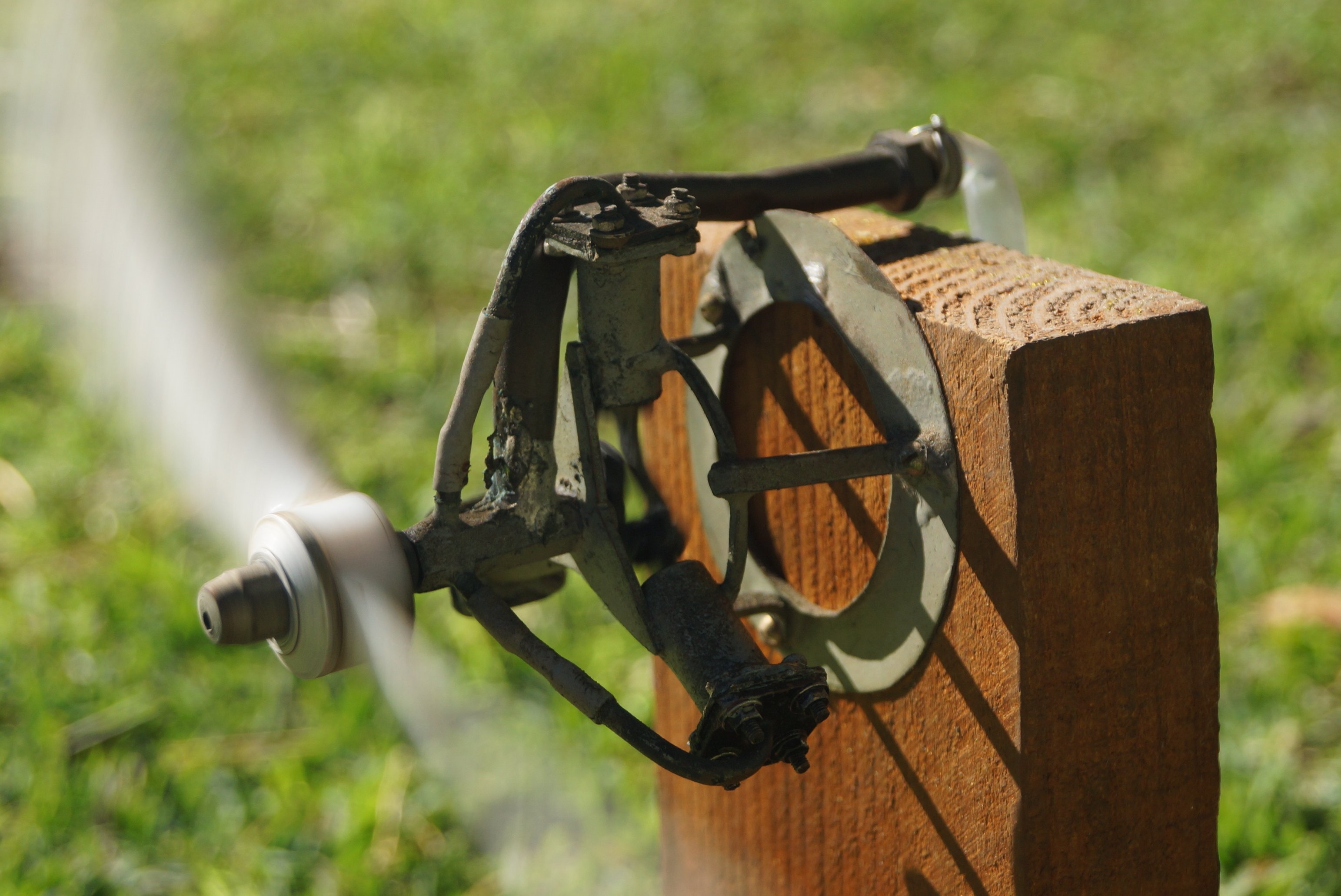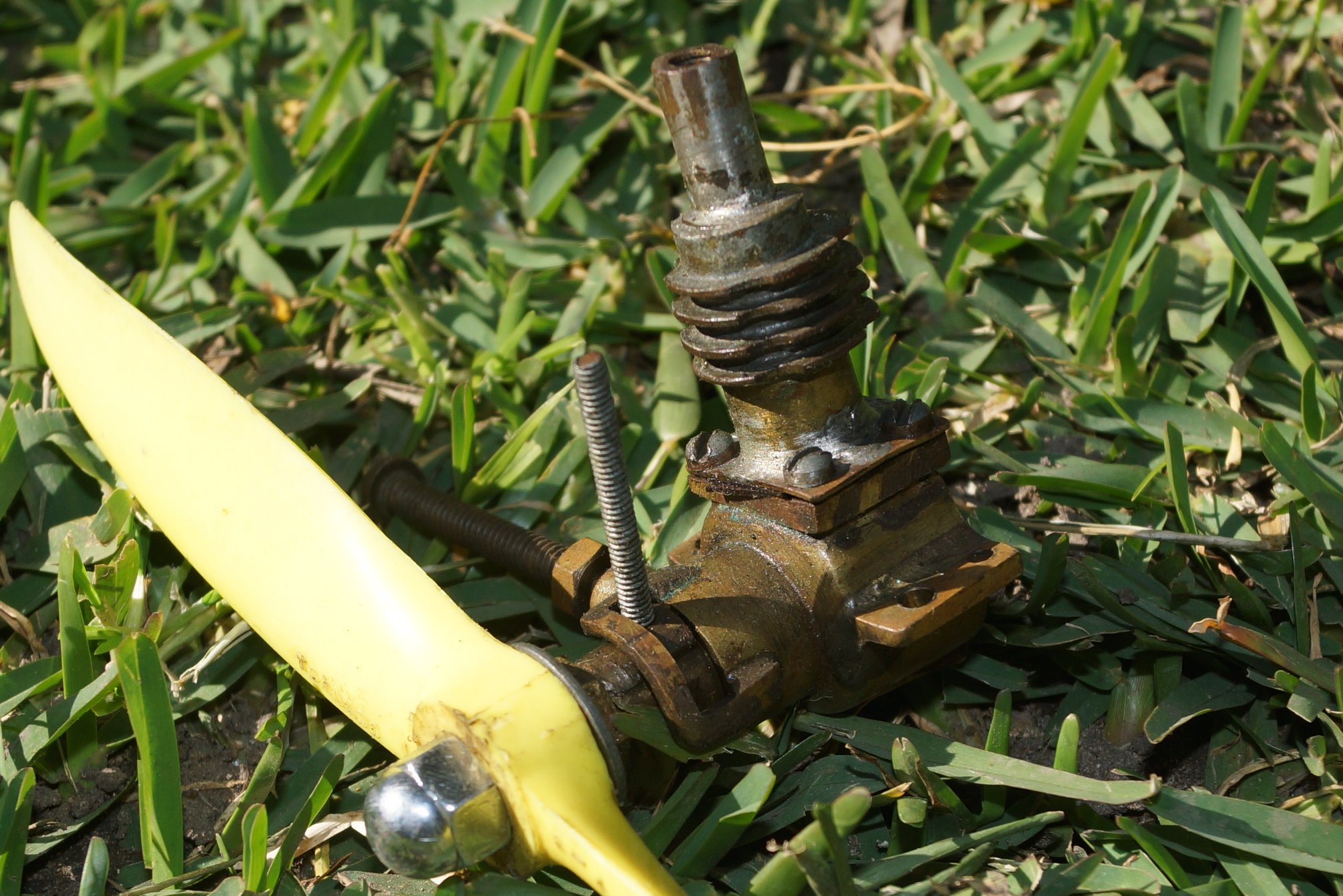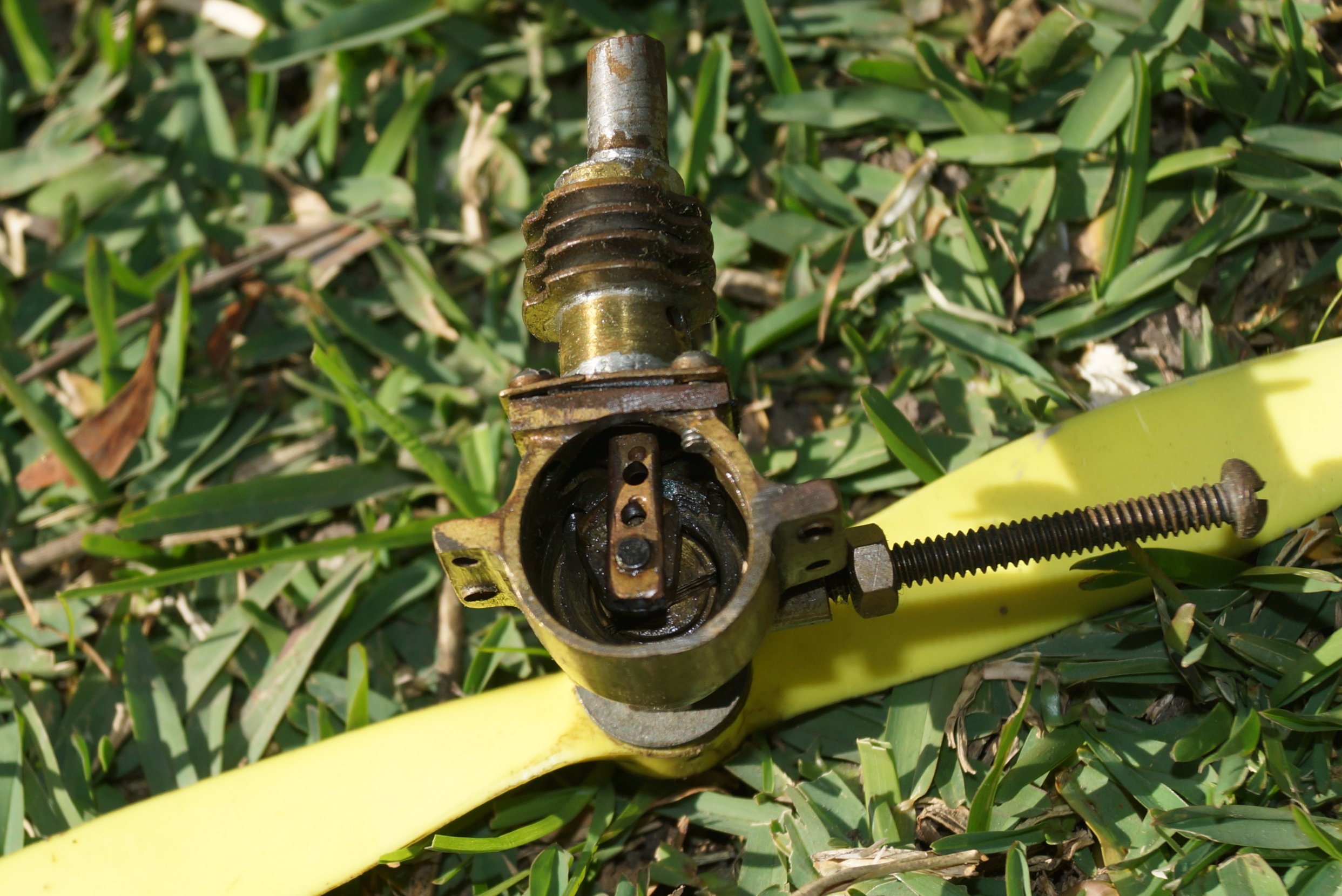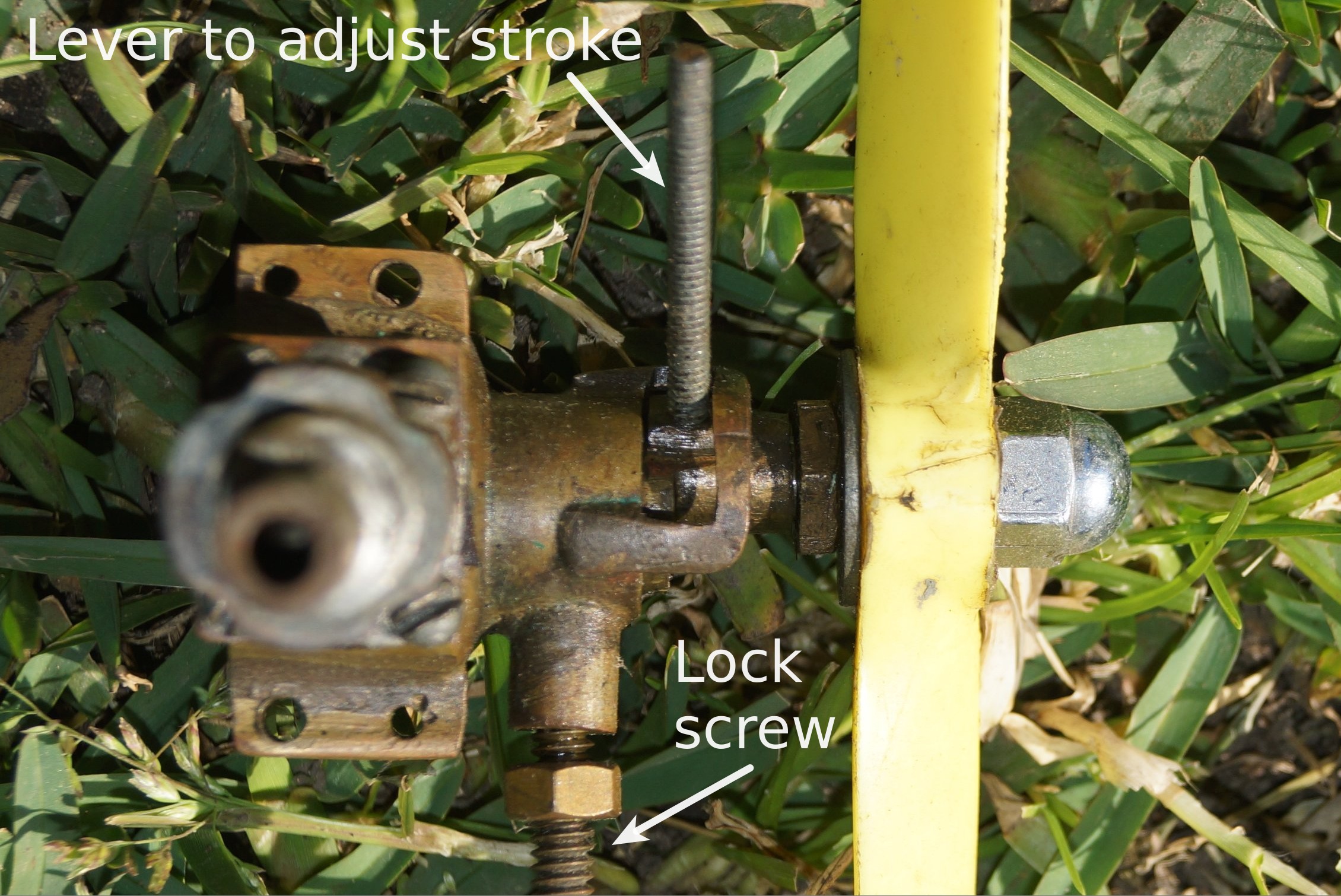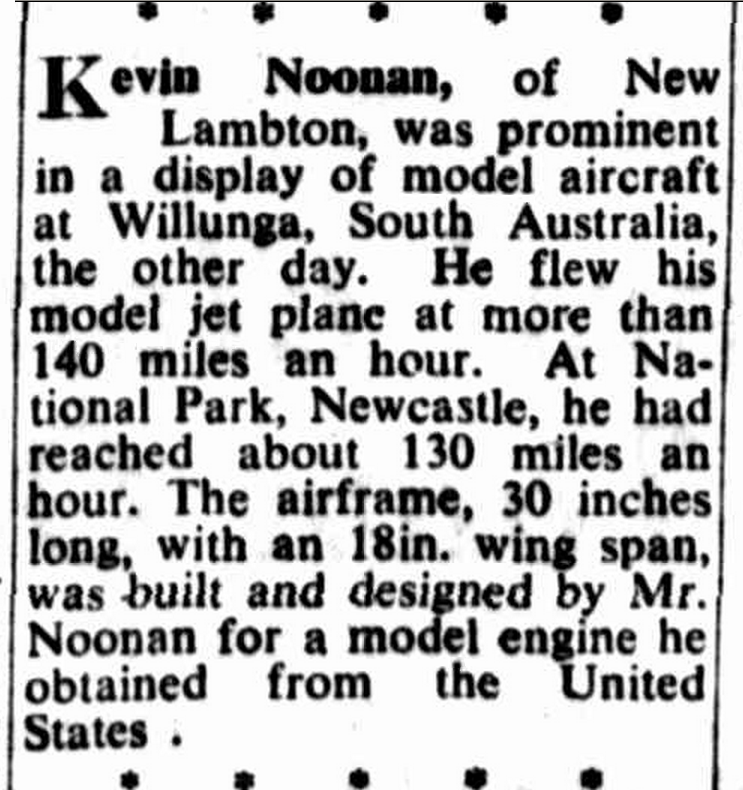Clem Noonan was the second of three brothers, Jack (John b.1916), Clem (b.1917), and Kevin (b.1927).
Barry Noonan (Jack’s eldest son) recalls that Kevin spent many years away from school due to rheumatic fever (a very nasty disease in those days) and had great difficulty reading and writing. Kevin, Clem and Jack were all magnificent with their hands – their technical ability knew no bounds. Both Jack and Clem left school at a young age due to the great depression. Barry understands that before the war his father Jack worked as a radio technician for a while and then as an apprentice boilermaker at Burwood colliery while Clem worked at Dawsons, a large engineering and tool store in Hunter Street Newcastle, NSW. Both men made up for their lack of formal education with their technical ability.
When he applied to join the air force on 17 April 1940 Clem said that he had been a member of The Australian Air League for about six months. But as you will see below, Clem had been interested in aircraft for a long time before he enlisted in the RAAF.
Early Career in Hardware and Joinery
Clem had worked for nine years in the hardware store of George Dawson and Sons by that time. My grandmother Shirley also worked for George Dawson. The store was in the Frederick Ash & Co. building opposite Civic railway gates in Newcastle (which stands today). My father Michael says his father worked out the back of the store in the ‘joinery’ section. By coincidence, Clem’s younger brother Kevin was a wood machinist by trade and at one time worked for Parker Furniture. He also would design and produce beautiful pieces of furniture in his spare time and particularly loved working in teak.
Clem was very capable and had a great love of technology. Michael Noonan said he often came home to Beach St Belmont South to find his father sitting up reading at 1am.
This Page 2 newspaper snippet from June 3, 1940 reports on the farewell party thrown for Clem when he left Dawsons hardware store to join the RAAF at Richmond.
An Early Joy Flight
The following photo indicates that Clem had flown low over Newcastle as a young man. Given the close proximity of the family home in Kings Rd, New Lambton to the Royal Newcastle Aero Club aerodrome in Broadmeadow it is not surprising that aviation and joy flying would fascinate Clem and his brothers. In 1940, civil aviation in general was approximately 20 years old (about the same age as the internet is in 2015). There is no date on this photograph but luckily there is a caption on the reverse as can be seen below.
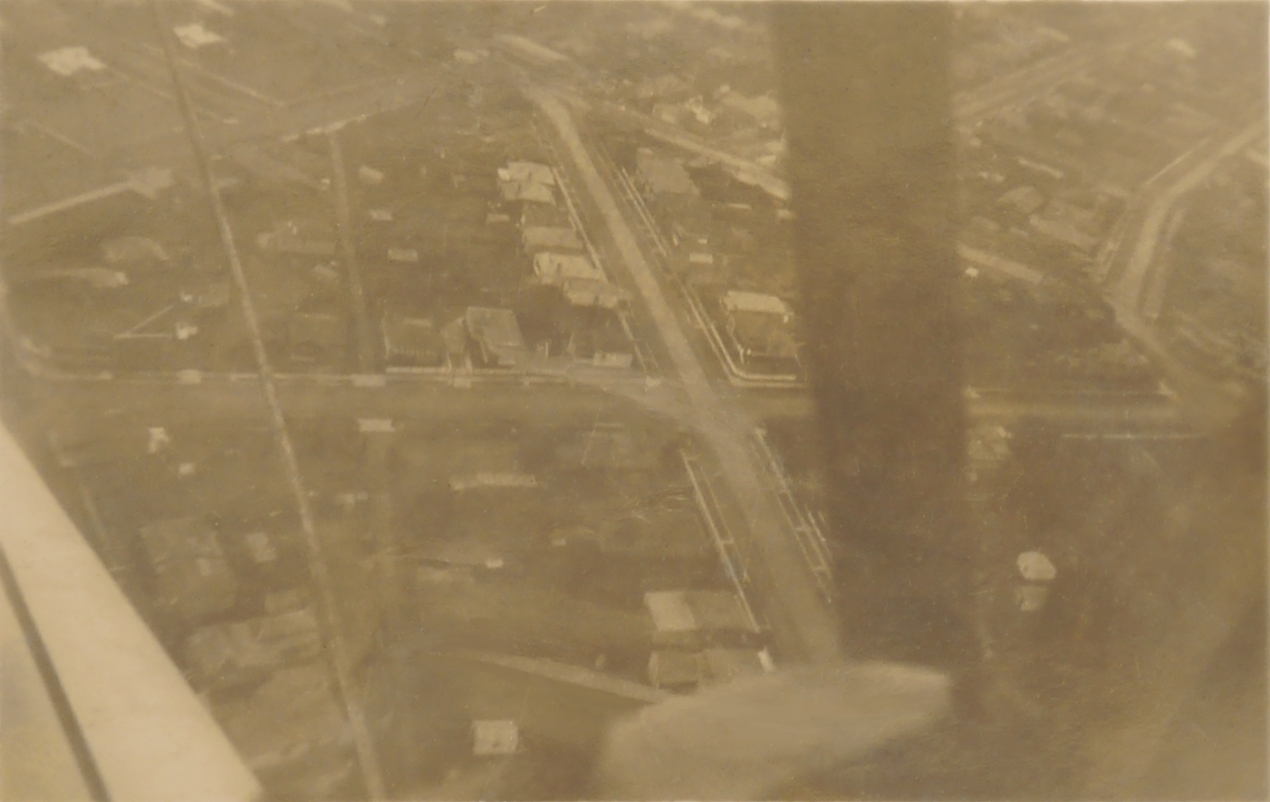 |
The Australian Air League
The Australian Air League (AAL) was founded in 1934 and exists to this day. Clem joined the League in late 1939 / early 1940.
This article from the ‘Newcastle Morning Herald and Miners Advocate’ of Monday 22 January, 1940 depicts Clem in a scene at The Australian Air League. He can be seen at the rear of the lower photo between the two men leaning in from the left and right.
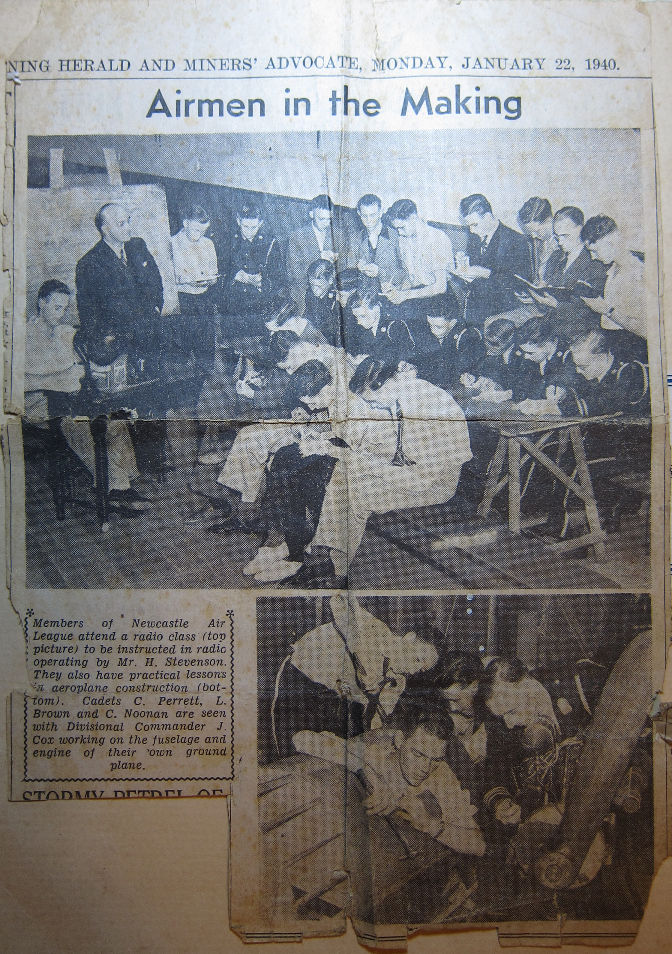 |
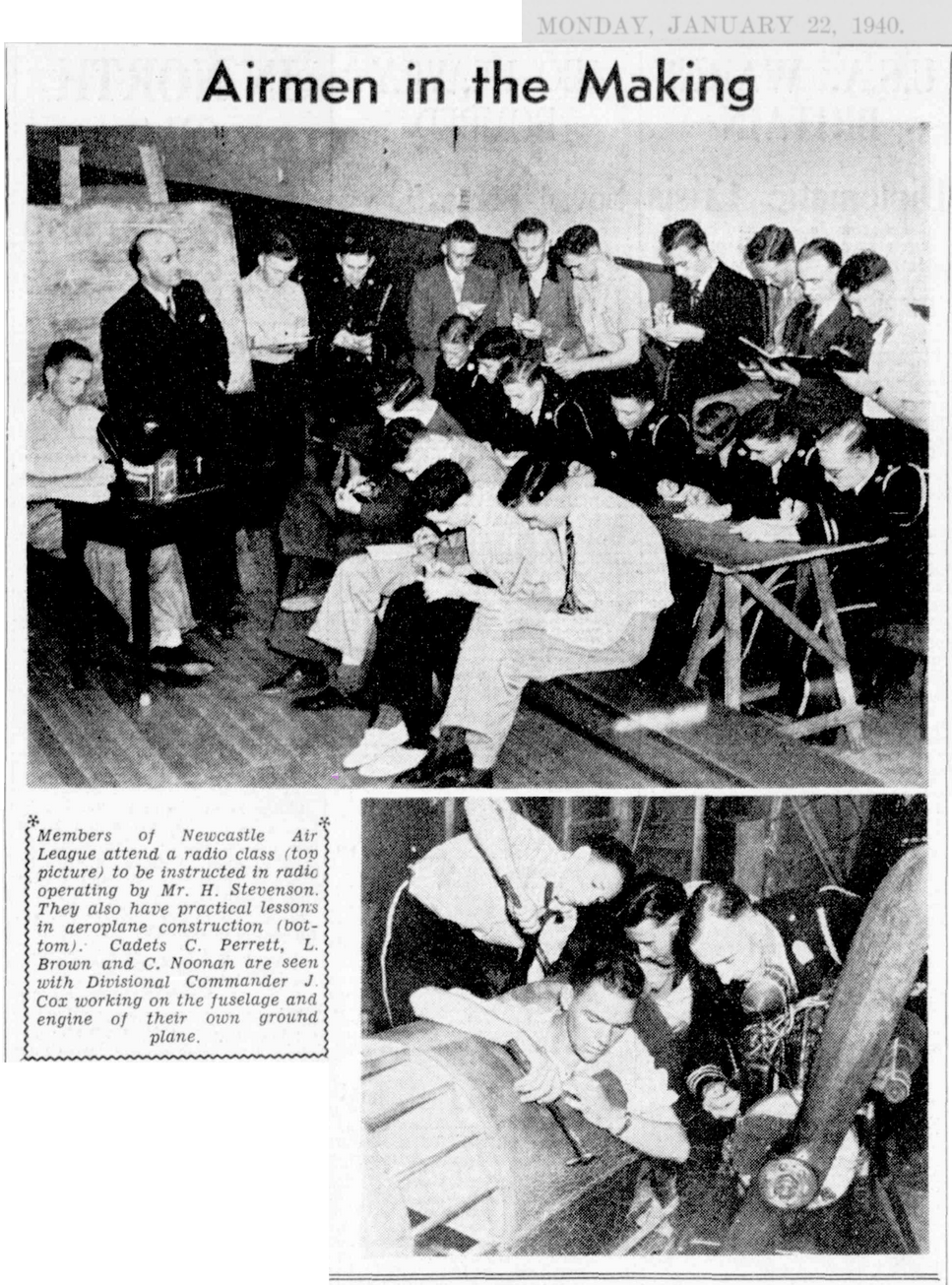 |
Clem obtained a copy of the photo that featured him in the newspaper. He also features in another Herald photo that was taken at the same time. These photos have become heavily wrinkled with age but restored copies can be seen below.
The second Herald photo was published on Page 5 the next day, Tuesday January 23, 1940, as seen below.
 |
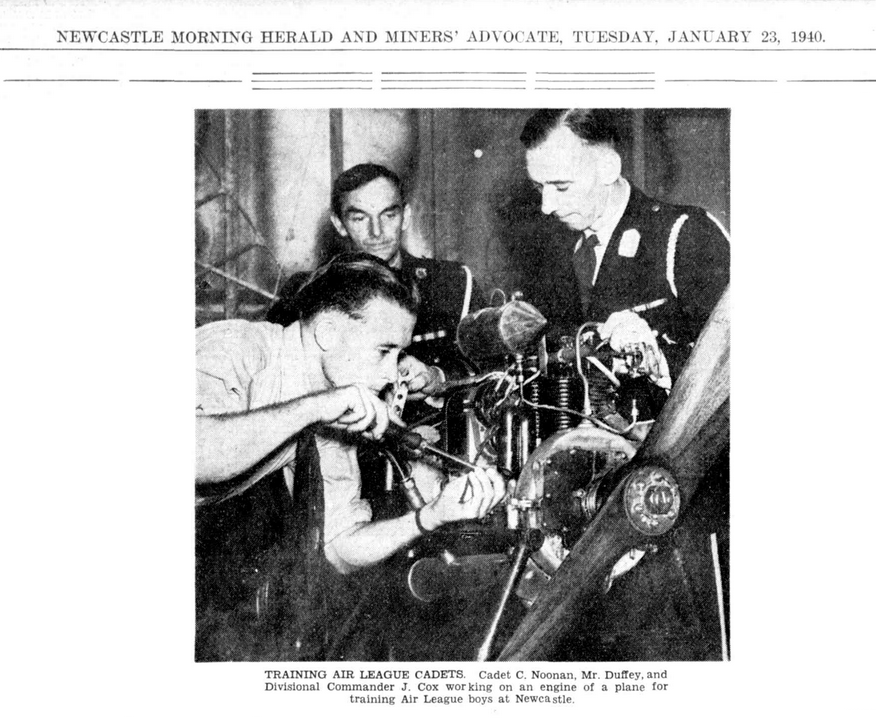 |
It is possible that the tail plane in the photo below belonged to the ‘ground plane’ of the Newcastle Branch of the Australian Air League.
 |
The photo above appears to have been taken in the back yard at Kings Rd New Lambton.
The Australian Air League would have provided Clem with the friendship of like minded people who shared his love of aviation, but it also proved significant for another reason. Clem’s second son Chris can recall his father telling him that the RAAF recruited directly from the AAL branches.
The Southern Cross Photo
It isn’t known when Clem obtained the following photo which commemorates the crew of the Southern Cross after the first ever Trans-Pacific flight. Clem was born in July 1917 and was about to turn 11 when the flight occurred. Barry Noonan (Clem’s nephew) has said that Charles Kingsford-Smith was the boyhood hero of his uncle Clem and father Jack (John). This must have been an influence on Kevin Noonan.
On joining the air force in 1940 Clem gained the rank of AC1 (Aircraftman Class 1). At some stage between 3 June 1940 and 1 July 1941 Clem wrote his name and his air force rank of AC1 on the back of the Southern Cross photo. I think Clem was very proud to be in the air force.
This photo has since become heavily wrinkled but a restored copy is presented below.
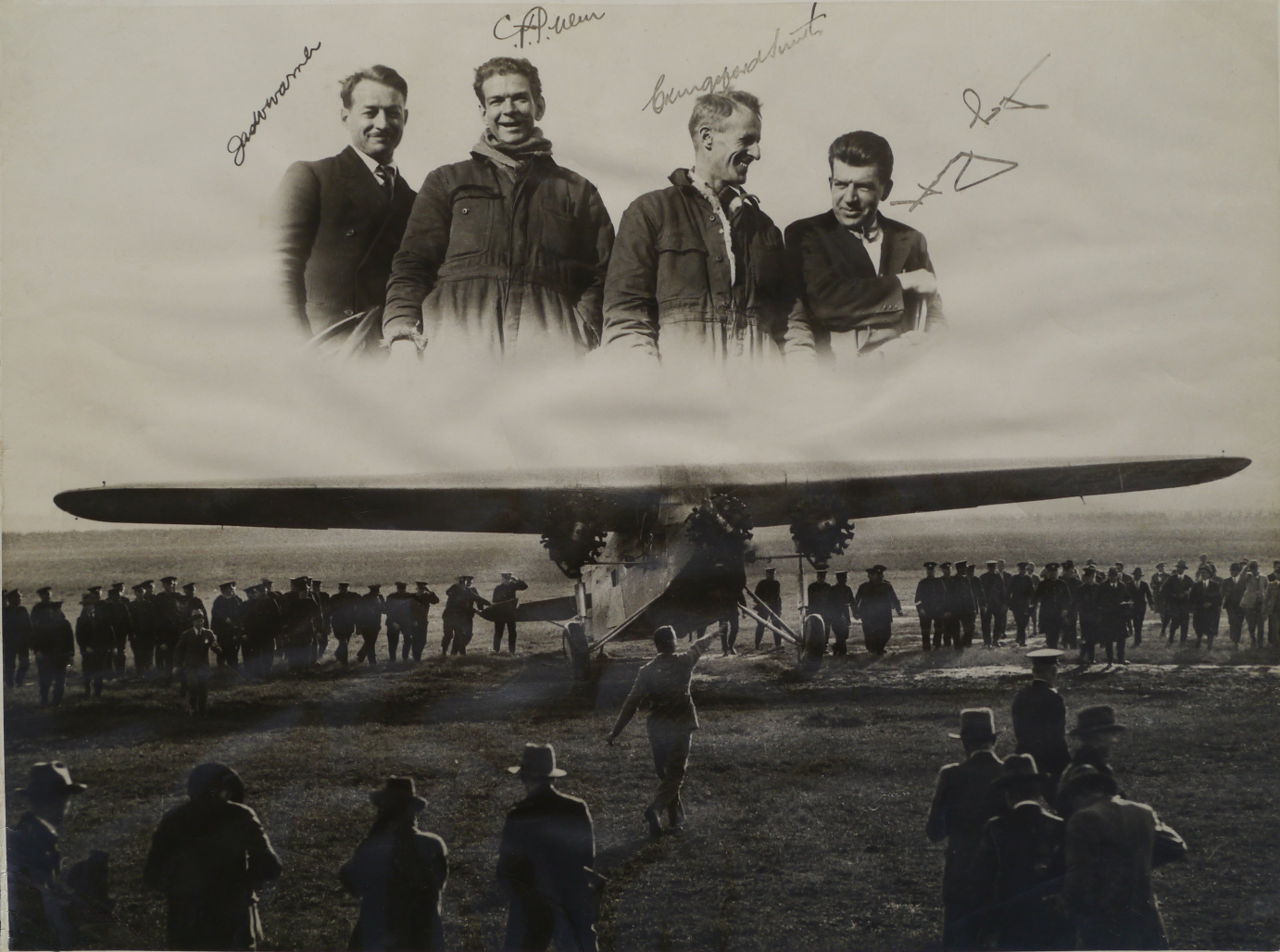 |

An Infectious Interest
Aviation was a major influence on the three brothers that grew up at 91 Kings Rd Lambton, NSW (Jack (John), Clem, and Kevin). But another young Noonan grew up in that household and his life would later revolve around aviation (Jack’s eldest son Barry).
Clem and Kevin Noonan had a strong influence on Barry. When Clem joined the RAAF in 1940, Barry wanted to join too. Clem’s wife (my grandmother) Shirley and Barry’s grandmother Mater even made Barry his very own RAAF tunic and cap. In a second photograph of Barry taken a few years later (c.1943) he is also wearing a child sized RAAF tunic. After Barry joined the RAAF and left Newcastle (and probably after Clem Noonan (senior)’s death on 22 August, 1973) Shirley held the photos on Barry’s behalf for over 20 years.
Barry clearly remembers the Southern Cross photo above hanging on the dining room wall of his and his grandparents home, as do my parents Michael and Patricia (Pat) Noonan. The love for all things aviation shared by Clem, Kevin and Barry later led Barry to apply for a commission in the RAAF. It was a career he had always wanted and he loved it for nearly 30 years. Barry joined the RAAF in 1961 and served in various locations in Australia and in Malaysia, Thailand, the United States and the United Kingdom before retiring in 1988. Along the way he spent a lot of time with Kevin and Clem which has informed much of the text on this page.
Barry recalls “Clem and Kevin collaborated on a number of things as their outlooks and interests were so similar. They were gifted with almost unlimited technological talent and manual dexterity coupled with imagination. At the same time both men could be quite stubborn, but also so very kind and display immense patience. The stubbornness and kindness were inherited from Mater (their mother), their patience was from Clem (their father). They shared interest in motorcycles, cars, aviation and radio/telecommunications. Back in the 1940s and 1950s at Kings Road if you wanted to read something you had infinite choice between Popular Mechanics, Flight, and aero modelling magazines – the only other thing lying around would be the Catholic Weekly but I doubt either of them read that too often! I loved both men equally – I owe so much to their love and encouragement.”
The Glider
Barry Noonan says that Clem and his older brother Jack designed and built from scratch a glider/sailplane in the backyard of the family home in Kings Road. It appears that Clem called this aircraft ‘Susie 1’. My father Michael Noonan said he had seen ‘a’ or ‘the’ wing of this aircraft sitting beside the fence in this backyard for a number of years. Barry Noonan also saw the remnants of the glider/sailplane at Kings Rd when he grew up. As all three brothers shared a love of aviation it is possible that the aircraft was built with the help of Clem’s younger brother Kevin.
 |
Notice Clem’s clothing in the photos above and below appears to be air force issue and he is wearing ‘Corporal’ chevrons on his sleeves.
 |
Clem was promoted to Corporal on 1 September 1942 and arrived at No.2 Embarkation Depot on 28 July 1943 to go overseas. A review of page 2 of his leave card suggests the photos above were taken during one of the following three 4 day leave breaks.
1) 26 September to 29 September 1942 inclusive.
2) 15 February to 22 February 1943 inclusive.
3) 30 May to 2 June 1943 inclusive.
Although only a small boy at that time Barry still has flashes of memory from the period and distinctly recalls Clem coming home to New Lambton on home leave (staying over on two occasions). One of these occasions may correspond with one of the dates above.
The tail of the aircraft can be seen sitting on some type of jig (and part of a chair) in the following restored photo.
 |
If you look carefully to the right of the tail in the photo above you will see what may be a wing of this aeroplane, as pictured in the restored photo below. This photo was also taken in the back yard at Kings Rd New Lambton.
 |
Clem refers to this Glider as ‘Susie 1’ on the back of the wing photo as seen below.
 |
Clem’s youngest daughter Leonie heard stories of “Clem and Kevin launching it off high places to test it.” As a child I remember seeing full size aeroplane tail surface templates hanging from the wall in Clem’s workshed at Belmont South. I think they were a chalkboard green colour. They hung there for years, but that is all I recall.
The photo below may have nothing to do with the glider ‘Susie 1’. However, based on the sepia tone and it depicting a rudimentary model aircraft sitting on a fabric covered wing, this photo may have been taken at a similar time. Nothing is known about this image found among Clem’s photos.
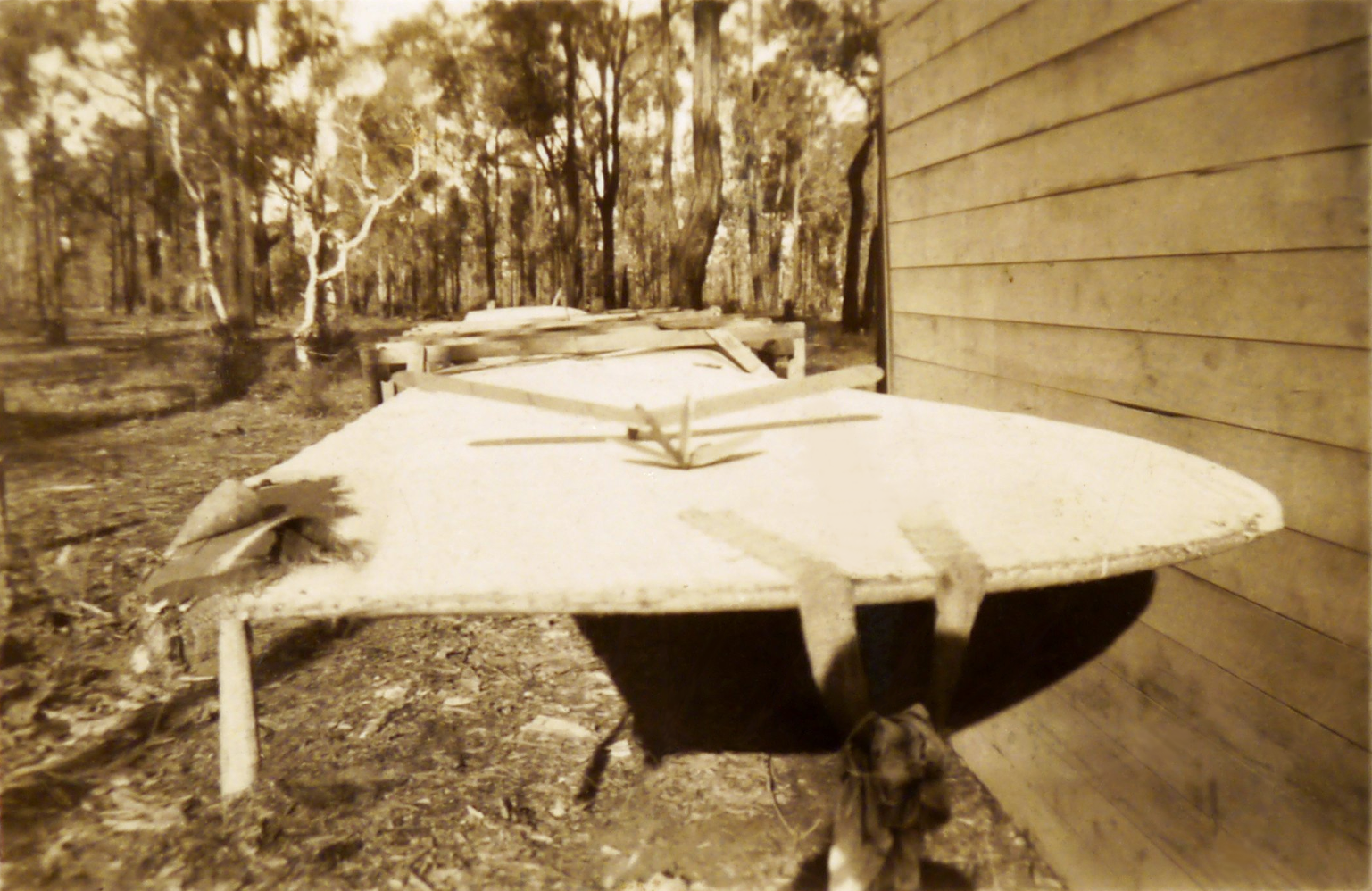 |
POST-WAR – The Autogyro / Gyrocopter
Michael Noonan says that Clem and Kevin also built an autogyro, and Michael can remember seeing the complex vertical drive mechanism for it. “One day dad just went off (with Kevin) and Kevin flew it. It took off, but fell heavily to ground and Kevin was injured. Not in a way he didn’t recover from, but he was injured in the crash landing”. Barry Noonan was present. He says that the test flight occurred at the old emergency (air)strip near Tomago, just north of Newcastle NSW in about 1965, and that while Kevin limped away from the crash, he had “nearly killed himself” in this machine “he had designed and built”. Michael never saw it fly and has never seen a photo of it. It would be unfortunate but perhaps there are none.
The following image depicts a typical autogyro design (this one from the 1950’s).
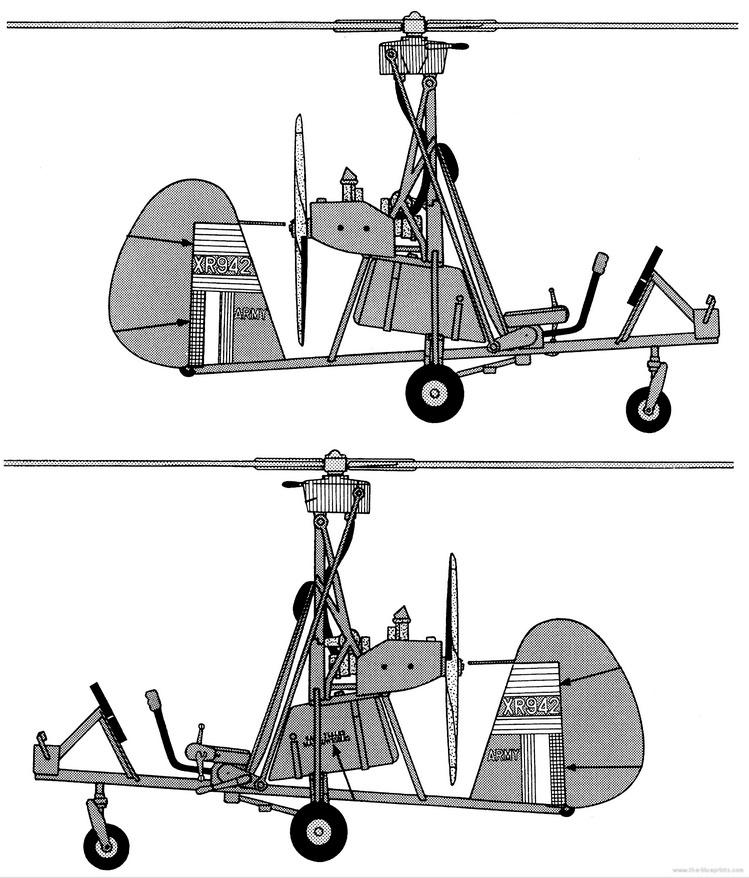 |
Tony (Anthony) Noonan says he thinks he can remember the officials (The Department of Civil Aviation?) being called in over Kevin’s test flight and subsequent crash in the autogyro/gyrocopter and that there may have been legal ramifications.
Barry remembers Clem and Kevin building and flying a couple of free-flight models and also exploring the possibility of building an ultra-light aircraft, but they never went on to full-size to his knowledge “neither could have afforded it for starters”.
POST-WAR – Clem’s Photo of the Clem ‘Gold Bug’
The aircraft in the following photo was originally built in 1920. Called the ‘Gold Bug’ and registered N149C, it was fitted with a 30hp motorcycle engine. It was reportedly the first monoplane designed and built in Wichita, USA. Its maker ‘Clem’ was a mechanic and machinist with the Cessna Co, later Stearman.
The photo appears to be a copy of a picture in a book or magazine. Based on the American car visible in the photo, the picture appears to show the 1958 restoration of the ‘Clem Gold Bug’. The ‘N149C’ registration was cancelled in August 1974.
It is likely that the aircraft appealed to Clem because of the name of its designer and because of the possibility of building an aircraft like this himself.
 |
POST-WAR – Air Navigation ‘Races’
Leonie remembers Clem and his youngest brother Kevin entering air navigation competitions. Although reportedly unable to write, Kevin had his pilots licence and would hire a light aircraft from Bankstown in Sydney, NSW. Presumably Clem would navigate them to the designated ‘way points’ in the competition.
Chris Noonan can also recall Clem and Kevin entering these events. Chris dates them to the 1970’s and says that the Bankstown company who hired Kevin the light aircraft was owned by none other than Jack (later Sir Jack) Brabham, the famous Australian race car driver.
Clem invited Leonie to join them on one occasion (~1972) but she did not want to go. During the race the aircraft developed fuel problems and was only able to draw fuel from one wing. As the heavy wing dropped, the light aircraft became highly unstable which made for a very hairy landing.
POST-WAR – Model Aircraft
Clem greatly enjoyed building and flying model aircraft when I knew him in the early 1980’s (including control line aircraft). He used to make his own radio control equipment such as radio receivers and radio controlled servo motors. Leonie says he was working on a model aircraft when he passed away in 1984. He would take it to the paddocks at Belmont South to test it.
As will be seen below, by this time Clem had already shared his model aircraft interest with his brother Kevin and nephew Barry for decades. In 1950 Kevin was the Secretary of the Newcastle branch of the Model Flying Club of NSW.
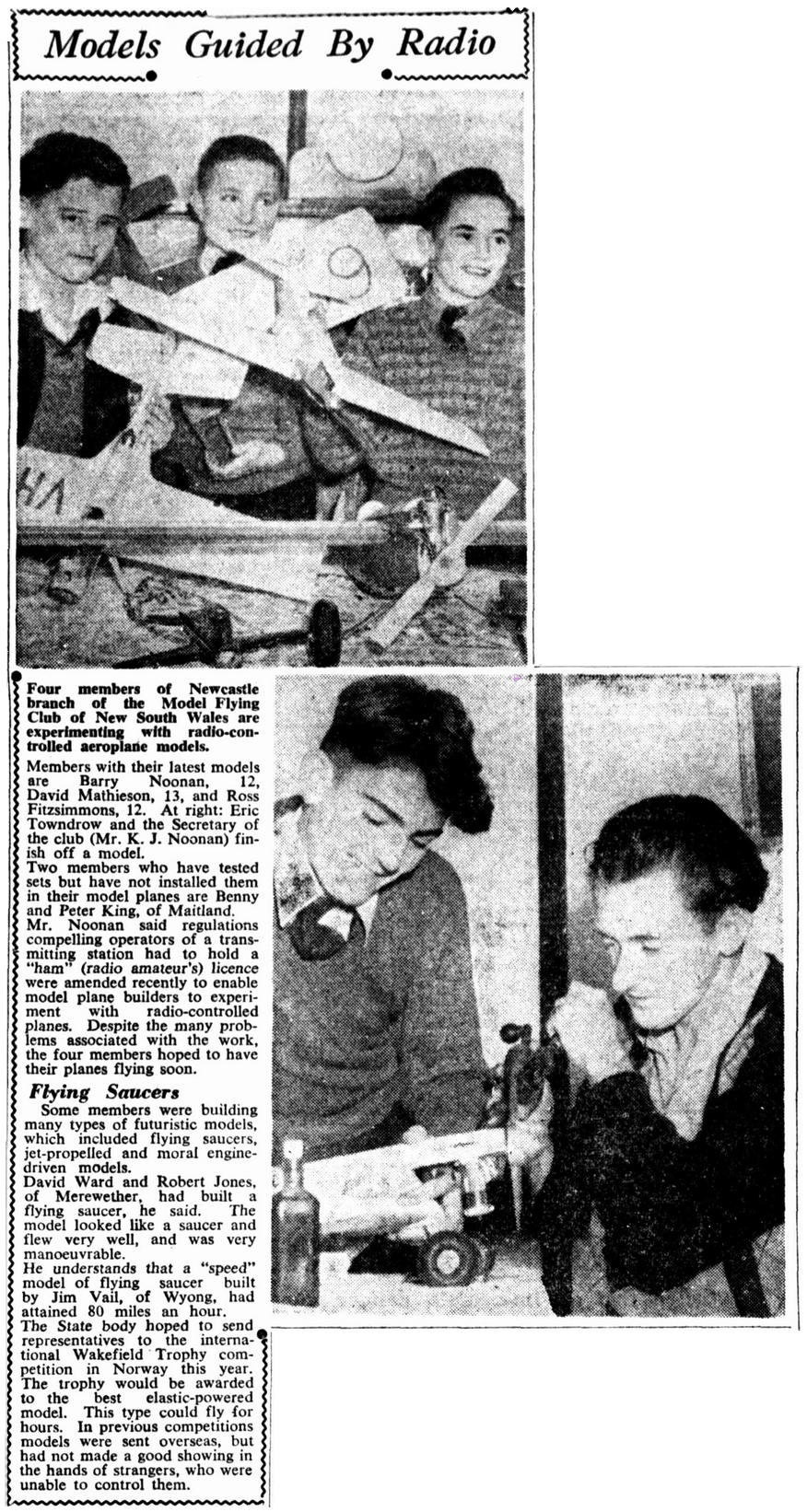 |
Barry has related that Clem “was an expert in the use of compressed air driven engines for free flight models”, and “he used to build his own engines and compressed air cylinders. These were as small as 5cc capacity. Kevin also built engines, but not compressed air.” Barry cannot recall if they designed the engines themselves or used plans from model magazines. Barry remembers that “Kevin had a Myford ML7 lathe set up in the back room at Kings Rd New Lambton which both he and Clem used to make the motors. They were a very highly skilled pair.”
Once such compressed air model engine Clem made was a three cylinder radial engine.
Click on the MP3 player below to hear the engine running.
Michael Noonan says that the fuselage of the aircraft would be fitted with a home made compressed air cylinder around 10″ (250mm) long. The cylinder would be made from very thin metal tube with the ends soldered on. The tanks would be wrapped in thin wire which was soldered to the tank to give extra strength. The tank would be filled using a bicycle tyre pump. The compressed air aircraft were launched by starting the engine, running and throwing the aircraft into the air. The engine gave a short burst of power to climb a model to a decent height. When the compressed air ran out the model would return to earth as a glider.
Other engines had a single cylinder. A very interesting feature of the single cylinder engine below was that the stroke of the piston could be varied before the aircraft was launched. This engine does not currently run.
Such models were flown in the sand dunes at Belmont South. It is possible that Michael was Clem’s only child to witness these compressed air models in operation.
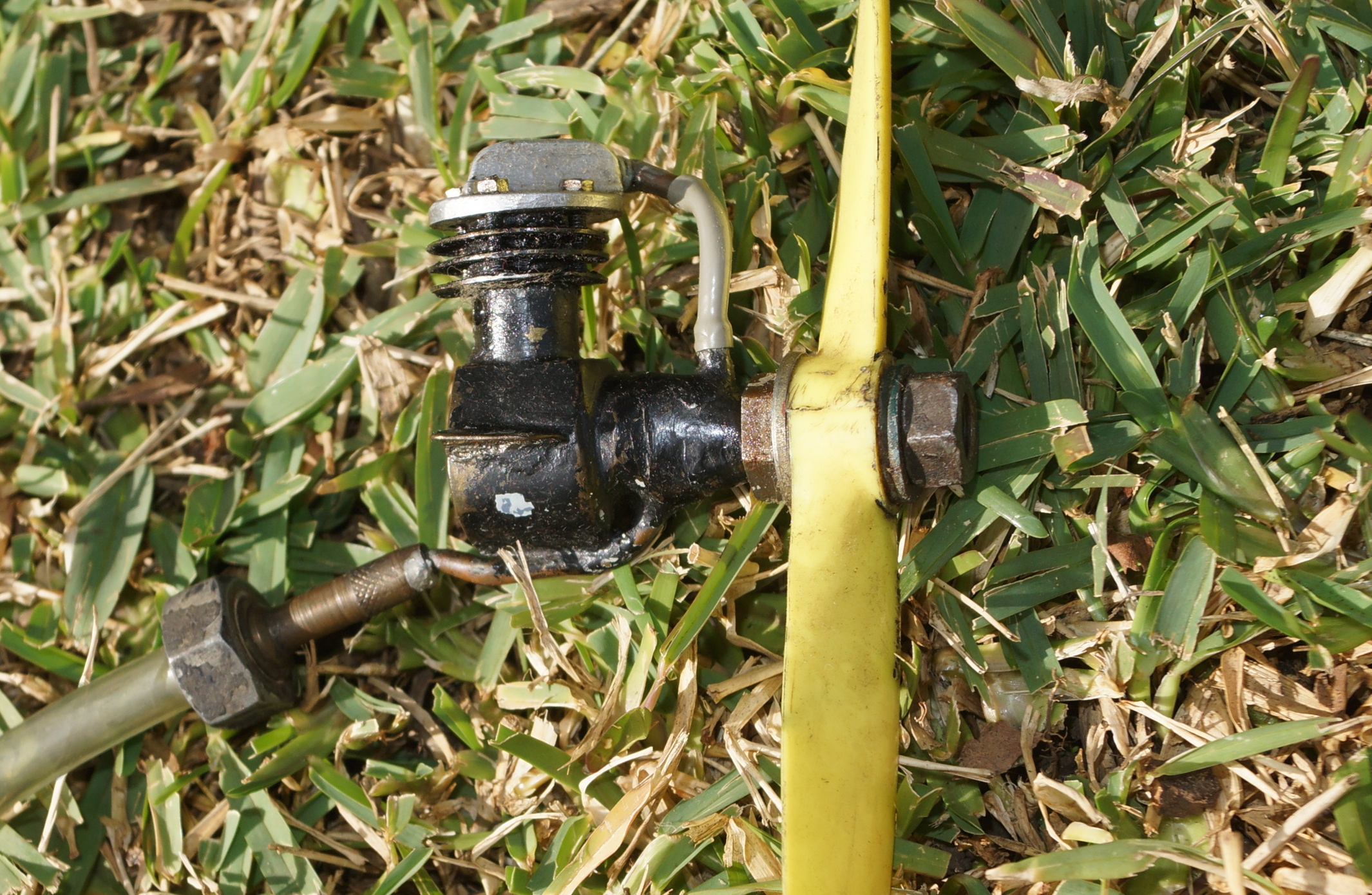 |
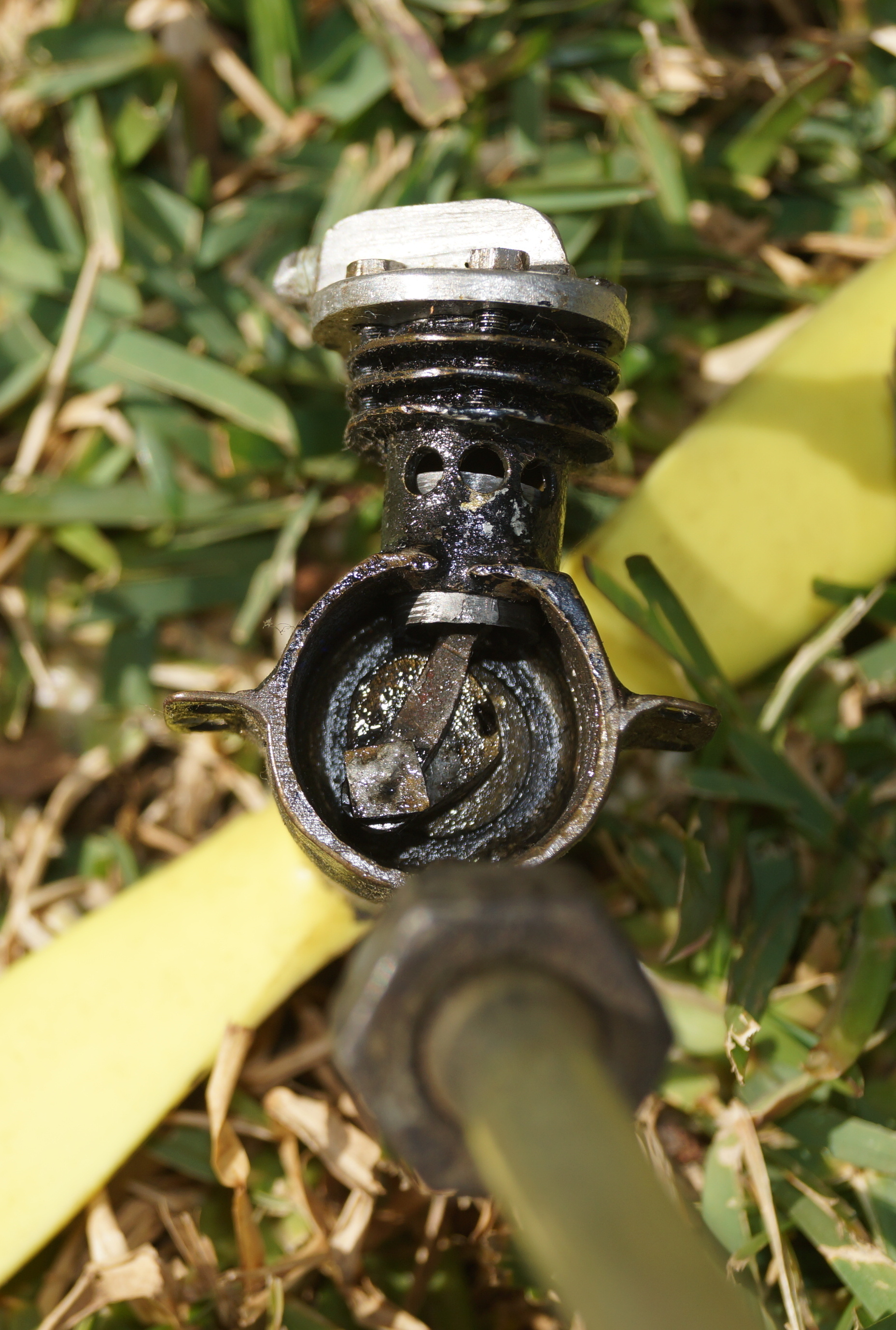 |
 |
 |
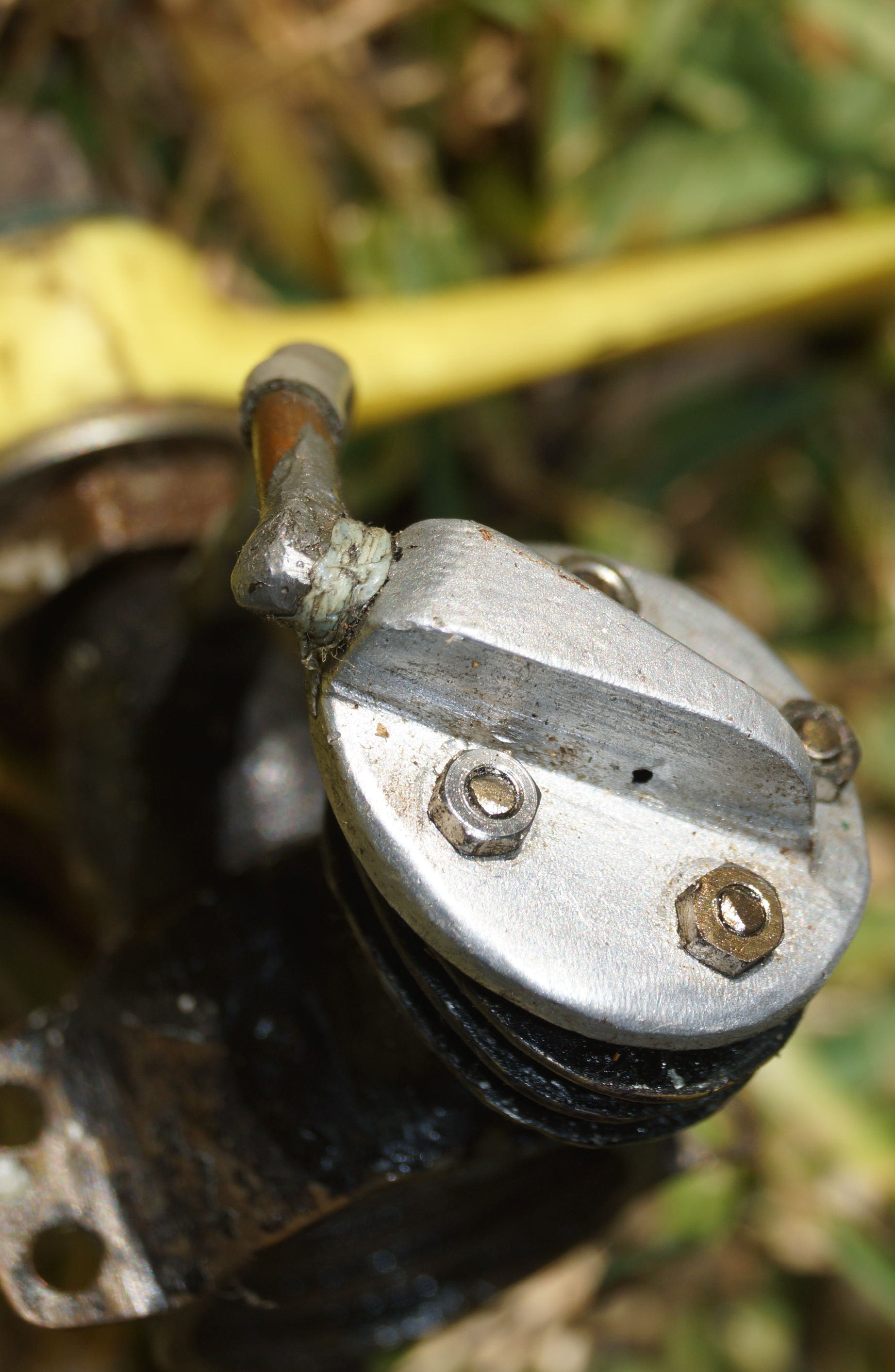 |
Fuel Powered Engines
Michael Noonan remembers that his father Clem and uncle Kevin would have a collection of about 12 two-stroke model aircraft engines in running condition at any one time. “Aircraft were all they would talk about when they were together”. Michael says some of the engines ran on ‘ether’ and others on a vegetable oil fuel as the engines were like diesel engines. Barry also remembers that “Clem and Kevin had many engines, some were petrol that had a spark plug and ran on a high octane petrol, some were diesel, and also there were engines that used a glow plug that had a petrol/methanol mix.”
Clem and Kevin would sometimes run the engines inside Clem and Shirley’s home at 26 Beach St, Belmont South by clamping them to a bench or kitchen table with a G-clamp. On one occasion an engine sucked a plastic table cloth into the propeller. Clem and Kevin’s retort was that the engine must have started backwards! At one stage Michael had a couple of model engines of his own. I can recall a fairly large single cylinder model engine Clem gave to me (which must have been) shortly before he died, though I could never get it to run.
As Barry remembers it Clem was “mainly interested in free-flight models though I do recall a fairly large glider (wingspan about 1.5m – 2.0m) that he built. It used a diesel engine with a small tank limiting the amount of fuel to get it to altitude. It was trimmed to move in wide circles and first flew in the sand-dunes area at the end of Beach Street (Belmont South, NSW). Another time one of his free-flight models was launched not far from our place in Kings Rd and went missing but was later tracked down to west Mayfield and recovered.”
Models by Clem
The following photographs were taken in July 1978 and show a free flight model glider built by Clem towards the end of his life. He built the radio control equipment from scratch. According to several of his children Clem had gained considerable reknown for the design and construction of successful radio control equipment (ground control boxes, and receivers and servo motors in the aircraft).
 |
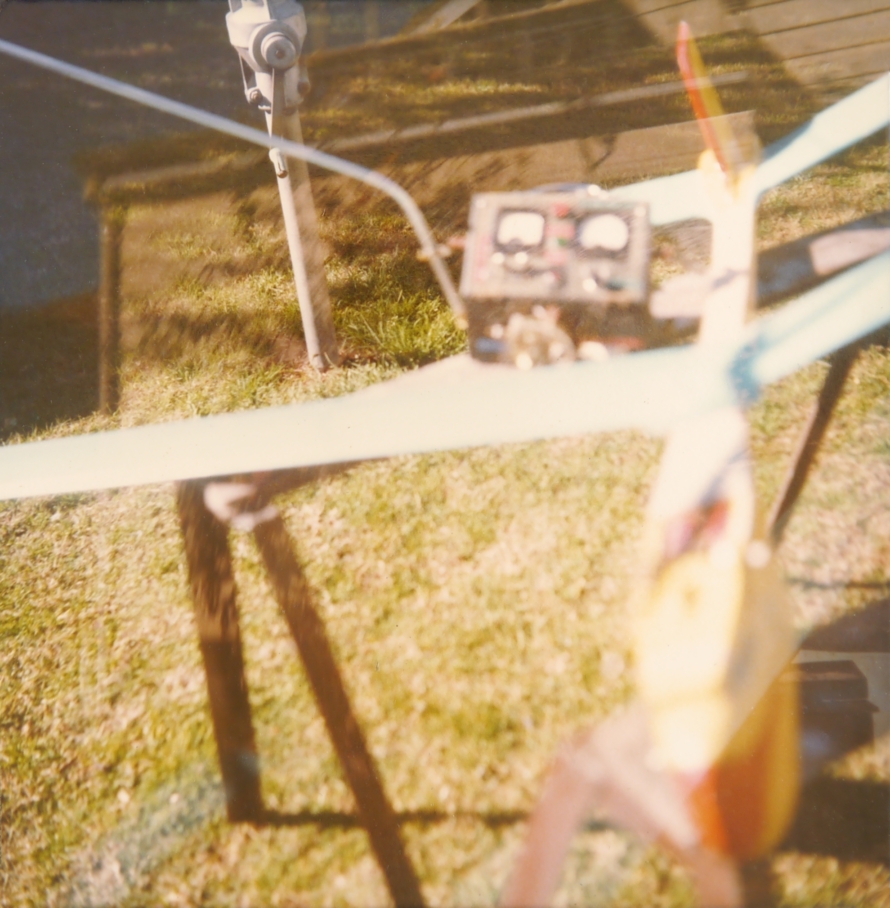 |
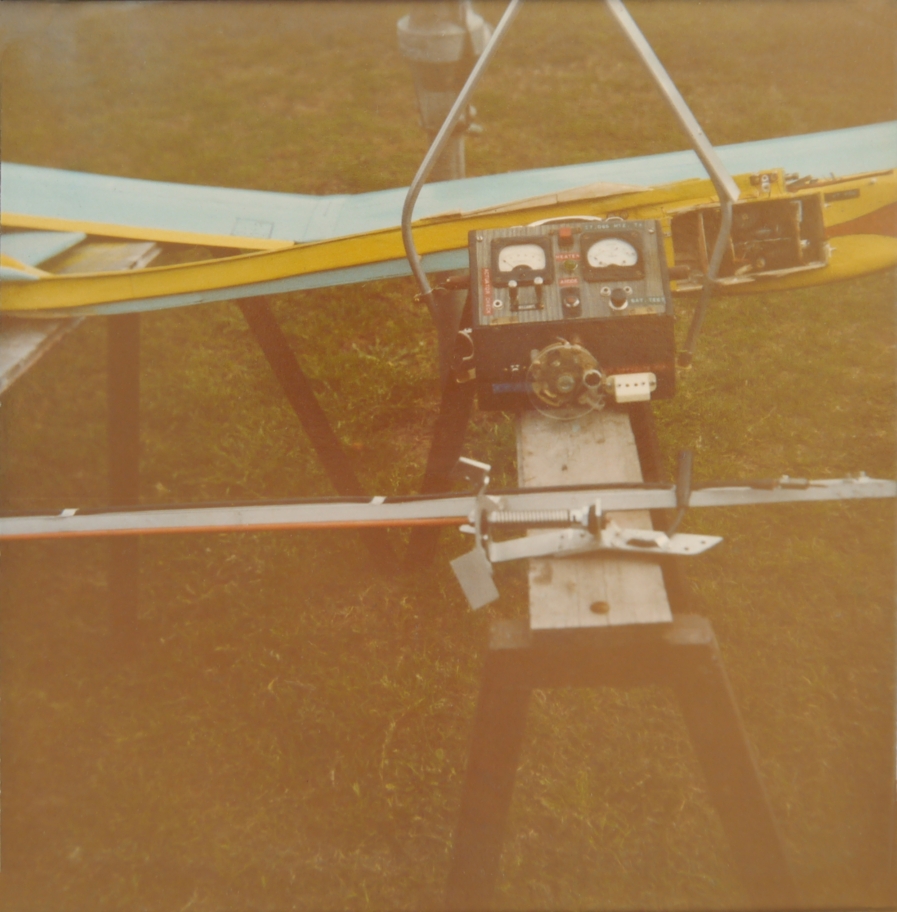 |

|
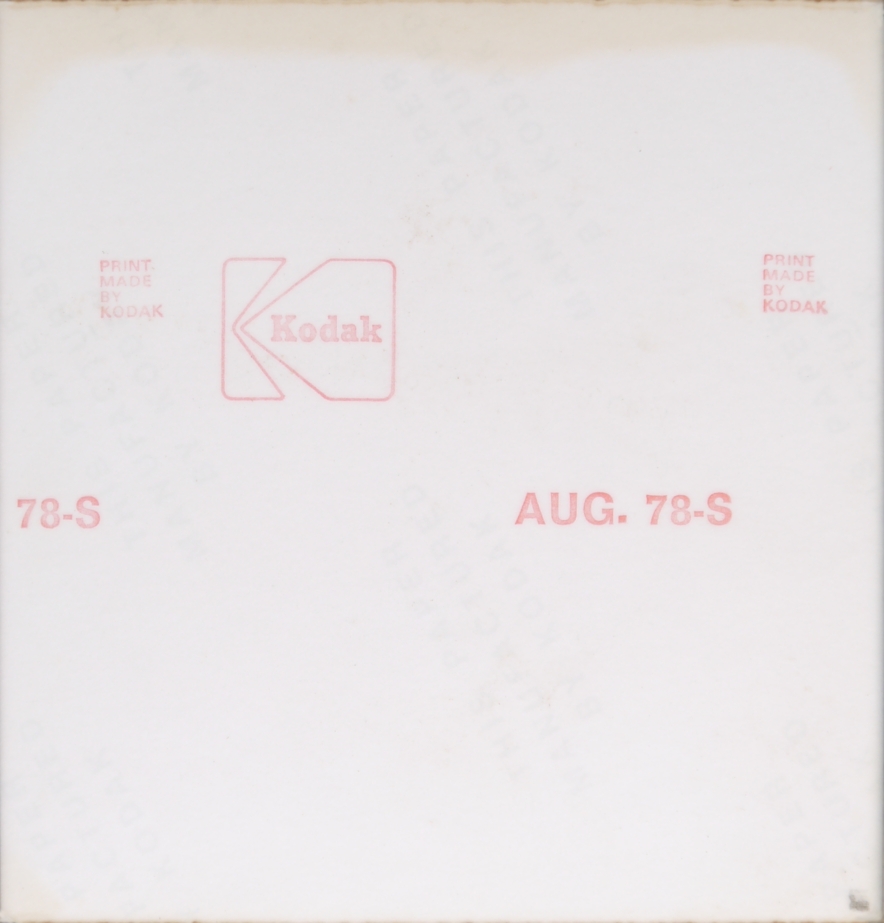
|
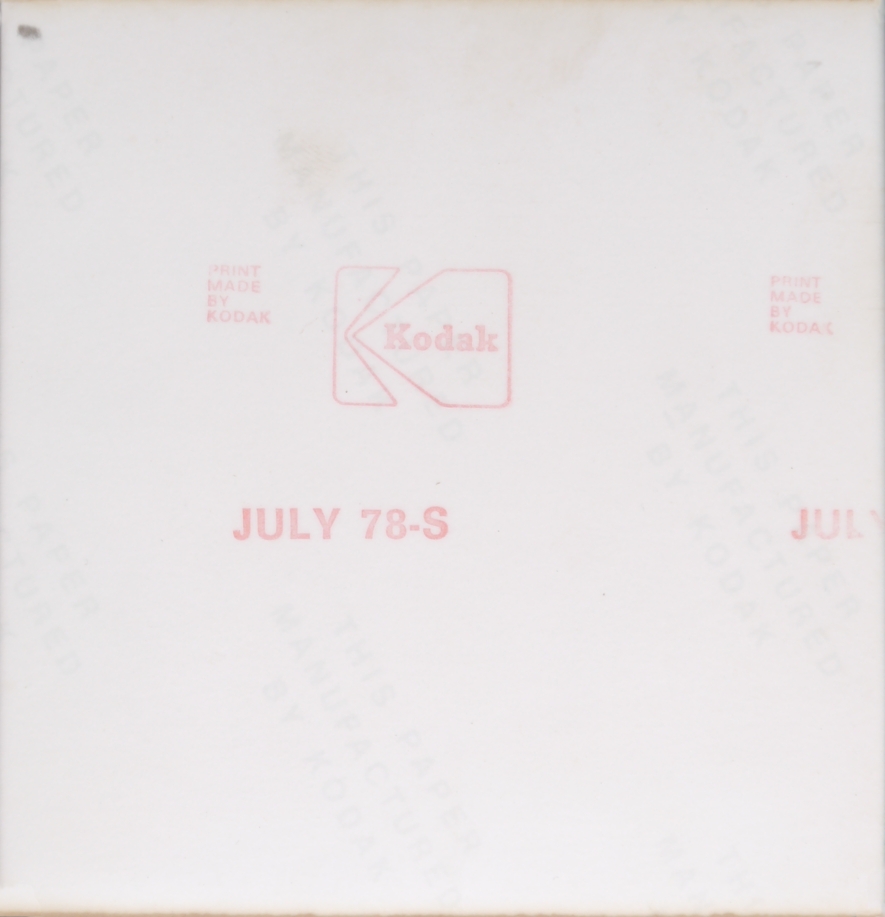
|
After Clem’s death this model came home to my family in Valentine. After many years of minimal use it was unfortunately scrapped.
Other Models
Barry recalls that “Kevin was exclusively keen on control-line models and was something of a pioneer in their development. He flew both stunt and speed models at shows all over – the models ranged from 2cc to more than 10cc engines – he used glow plug motors the most and was forever poor due to their high cost back then. His coup de grace was the Dyna-Jet Redhead engine he imported from the US and flew at several Newcastle shows. It was noisier than a Mirage and could be heard two suburbs away – I was quite terrified of it because of the noise and the red-hot exhaust pipe/jet flame discharge. But it certainly flew, and fast – on 100ft (30m) control lines that would make Kevin dizzy with its speed through the laps and him holding on like grim hell in the centre. Fortunately it never broke the control lines otherwise it would have killed one of the spectators.”
The following internet sourced images show a page from an interesting original Red Head manual. Also shown are a ‘new build’ Dyna Jet Red Head in production in 2015 that is identical to the 1950’s engine, and an example of a 1950’s control line model aircraft powered by a Red Head. Based on a description in the newspaper article titled “Jet Plane Flies At Show” seen below, the ‘Hot Canary’ model sounds similar to a model designed and built by Kevin Noonan.
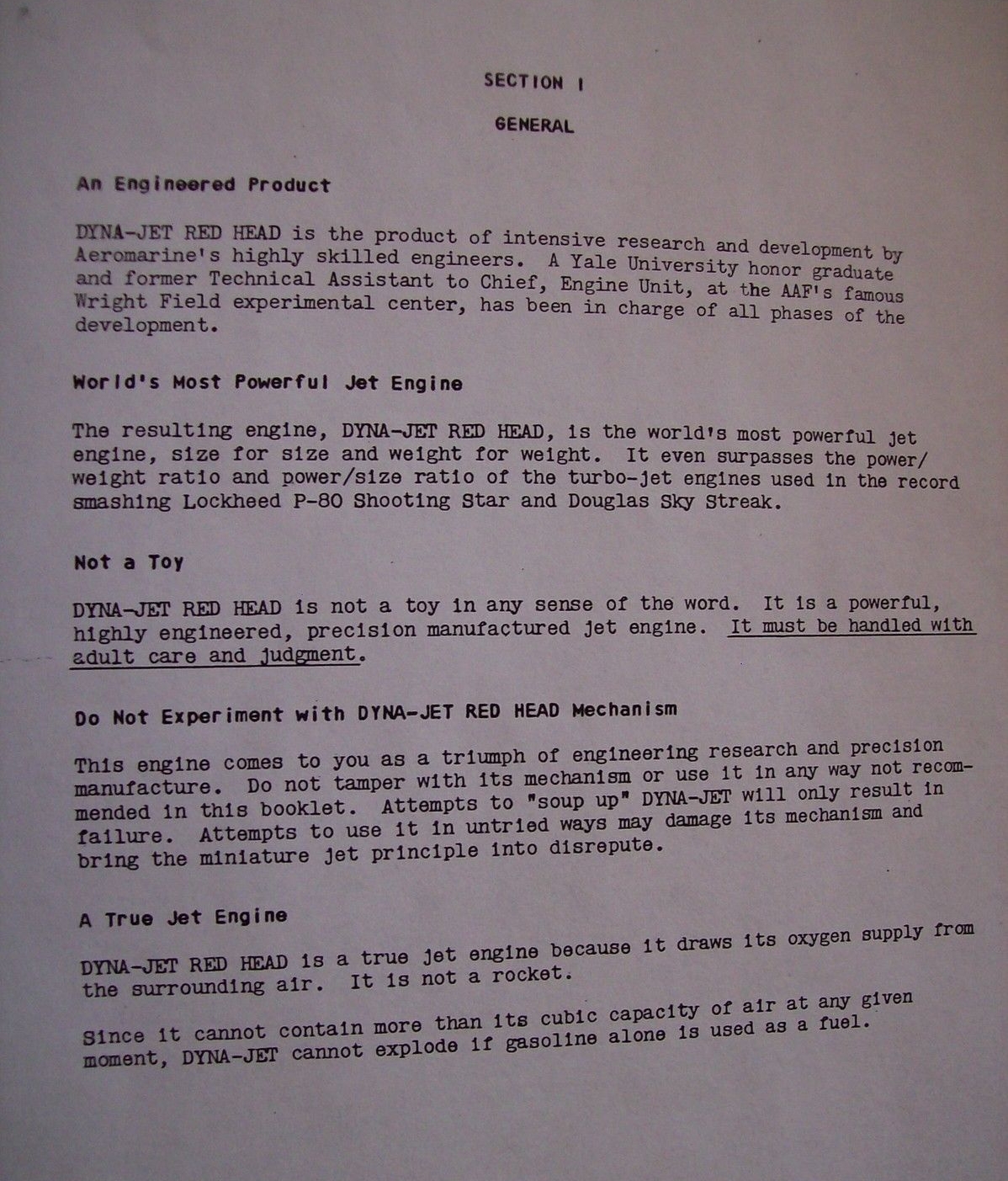 |
Kevin Noonan competed in the Australian (model flying) Championships as can be seen in this 1948 newspaper article.
 |
The following photograph appears to show Kevin (at right) with competition model No. 31 of the ‘Hunter’ Division of the Model Flying Club of NSW (Note ‘M F C N S W’ on port wing).
 |
The following image shows Kevin holding two trophies. Michael Noonan believes these were model aircraft competition prizes. The original photo will appear if you click on the cropped image below.
 |
Kevin had achieved some renown for having the first jet model engine in Newcastle. Michael can remember the incredible scream this engine made when it ran, and he remembers how fast it flew in comparison with propeller powered models. Michael says that Clem and Kevin had built a special jig so they could run this engine on the ground.
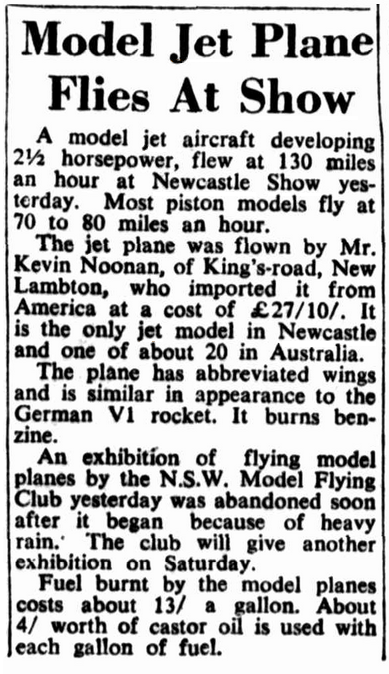 |
The amusing article below was published on 28 November 1951 and outlines an attempt by Kevin to break the model jet speed record on 1 December 1951. Almost a year later to the day (29 November 1952) the Newcastle Herald and Miners Advocate reported that Kevin and his model jet had recently achieved 140 miles per hour at Willunga in South Australia.
Barry is certain that at one stage Kevin held the world speed record for control-line model aircraft (a model jet). It has not been possible to verify this, with Barry noting that model aero clubs of the period were mainly informal groups and there would have only been a loose administrative structure joining them nationally or internationally.
It is clear how much Clem and Kevin loved technology. Forty or fifty years later Michael Noonan clearly remembers Kevin’s delight with a brand new spring loaded adjustable centre punch he’d just purchased. I chanced apon an identical punch at a garage sale at Lambton in or around 2011.
Besides making his own model aeroplane engines Clem also made his own wooden propellers.
 |
Otherwise all but one of the remnants of Clem’s model aircraft hobby are depicted below. The exception is the second (and black) single cylinder engine seen above.
 |
POST-WAR – Rutherford Airshow (circa 1978)
I have only one other personal anecdote to relate as regards Clem and his interest in aviation. It is also the only occasion that I can remember spending one on one time with a grandfather. The occasion was a public airshow held by the Royal Newcastle Aero Club at Rutherford, north west of Newcastle NSW, circa 1978.
By June 2014 my father Michael Noonan had found additional photos from his fathers collection and four of these are presented below. Three of the photos show Tiger Moths and I believe these photos depict the Tigers before or after a Tiger Moth Air Race (which were and still remain popular public events). As these races often revolved around the Newcastle Aero Club aerodrome at Rutherford, NSW and these photos were taken in September 1977, it is possible these photos were taken at the airshow Clem took me to.
The reverse of each photo is shown in the second row of the table.
 |
 |
 |
 |
 |
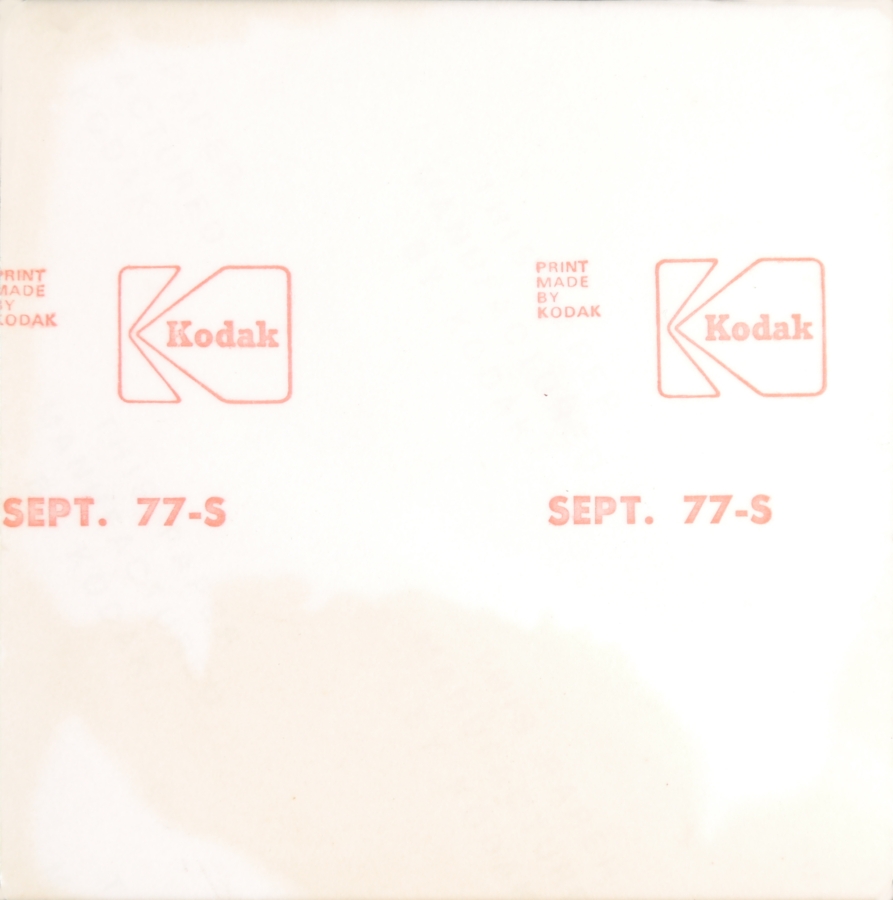 |
 |
 |
Clem drove me up there in his brown XY (?) Ford Falcon station wagon (which he drove fairly sedately) and I can recall him pointing out to me the particulars of a replica Fokker triplane painted in the colours of Germany’s most famous World War 1 ace ‘The Red Baron’ (Baron Manfred von Richtofen). I think the aircraft belonged at that time to Bill Hitchcock, a famous personality from the club. It may not have been full scale but it appeared to be airworthy. Either on the day or shortly thereafter I ended up with a plastic model kit of the Fokker which I enjoyed building.
On 5 July 2014 I was delighted to discover that a generally faithful replica of the Red Baron’s Fokker Dr.1 triplane is based at Caboolture, QLD, 45 minutes from where I live.
POST-WAR – Clem in his Shed at Belmont South
 |



